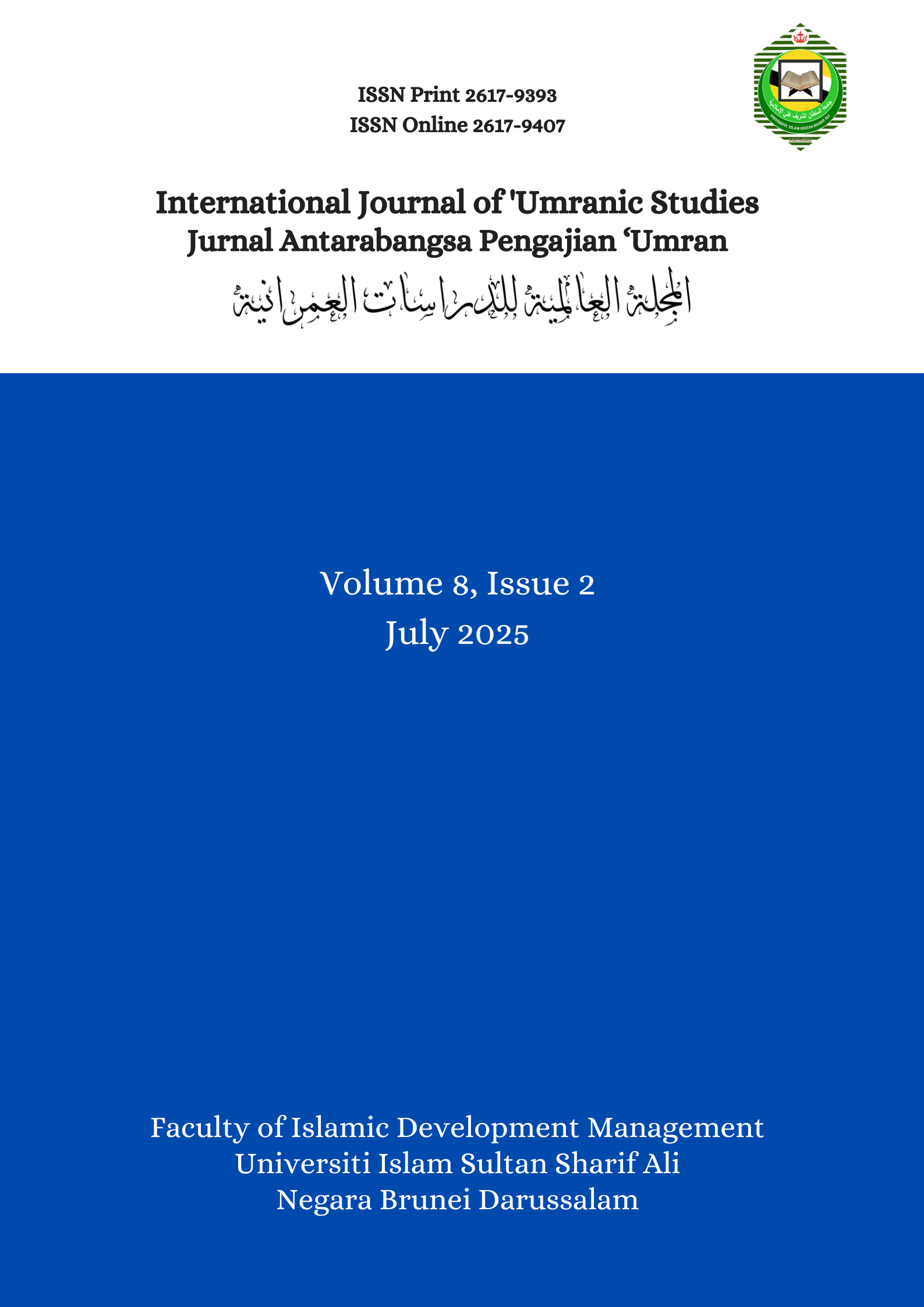مخارج الأصوات الصامتة في اللغتين العربية والملايوية: دراسة تقابلية : Points of articulation of the consonant sounds in Arabic and Malay: A contrastive study
Published 2025-07-31
Keywords
- مخارج، الأصوات الصامتة، اللغتان العربية والملايوية، أعضاء النطق، دراسة تقابلية
How to Cite

This work is licensed under a Creative Commons Attribution 4.0 International License.
Copyright NoticeAbstract
تصدر من أفواه الناس أصواتٌ كثيرةٌ ومتنوعةٌ أهمّها ما يعرف بالأصوات اللغوية التي تتمثل في الصوامت والصوائت من اللغات البشرية. وقد دُرستْ خصائص الصوامت وصفاتها في الدرس الصوتي الحديث من عدة أسس ومعايير عالمية ممثّلة في أربعة اعتبارات، أولها: مخارج الأصوات، والثاني: كيفية خروج الهواء، والثالث: حالة الوترين الصوتيين، والأخير: حالة مؤخرة اللسان عند النطق بهذه الأصوات الصامتة. وسميت الصوامت بالنظر إلى الاعتبار الأول بمسميات كثيرة ترجع إلى أسماء الأعضاء النطقية التي اشتركت في إنتاجها كالحنجرة والحلق واللهاة والطبق والغار واللِثة والأسنان والشفتين. ووصفت الصوامت كذلك بالنظر إلى الاعتبارات الأخرى بصفات عديدة كالانفجار ونصف الانفجار والاحتكاك والتكرار والأنفية والجانبية والهمس والجهر وغيرها. وهذا البحث سينصب - بالمقام الأول - على دراسة الصوامت من اللغتين العربية والملايوية في دراسة تقابلية تهدف إلى كشف الفروق وأوجه الشبه بين الشعبين العربي والملايوي في مخارج الأصوات الصامتة، وتحديد إمكانيات النطق التي استغلَّها الناطقون باللغتين عند إنتاج هذه الأصوات. وهذا يقتضي اقتصار البحث على دراسة صوامت اللغتين بالنظر إلى جانب واحد فقط من جوانب الاعتبارات السابقة وهو مواضع خروج هذه الأصوات عند النطق بها. ويحاول البحث كذلك التعريج على المشكلات التي قد يعاني منها دارسو اللغتين في النطق ببعض المفردات المشتملة على هذه الصوامت بسبب الفروق الناتجة عن اختلاف مخارج الأصوات لاختلافهم في استخدام إمكانيات النطق من الأعضاء النطقية.
ABSTRACT
People make many different sounds. The most important of them are known as linguistic sounds, which are represented by the consonants and vowels of human languages. The characteristics of consonants have been studied in modern phonetics based on several international foundations and standards, represented by four considerations, the first one is: the points of articulation, the second: the ways in which air exits, the third: the state of the two vocal cords, and the last: the condition of the back of the tongue when pronouncing these consonant sounds. In view of the first consideration, the consonants were given many names that go back to the names of the organs of speech that participated in their production, such as glottal consonant, pharyngeal consonant, uvular consonant, velar consonant, dental consonant and so on. Consonants were also described, in view of other considerations, with many characteristics, such as plosive, affricate, fricative, trill, nasal, lateral, voiceless, voiced, and others. This research will focus - primarily - on studying the consonants of the Arabic and Malay languages, in a constrastive study, aiming to reveal the differences and similarities between the Arab and Malay peoples in term of their points of articulation in producing their consonant sounds, as well as determining the pronunciation capabilities that speakers of the two languages employed when producing these sounds. This requires limiting the research to studying the consonants of the two languages by looking at only one aspect of the previous considerations, which is the points of articulation or the places where these sounds emerge when they are pronounced. The research also attempts to address the problems that learners of both languages may suffer from in pronouncing some words that includes these consonants due to the differences resulting from the different sound outputs in using the pronunciation capabilities of the articulatory organs.
References
- ابن جني، أبو الفتح عثمان ابن جني. 2000م. سر صناعة الإعراب. بيروت: دار الكتب العلمية.
- ابن دريد، أبو بكر محمد بن الحسن. 1987م. جمهرة اللغة. بيروت: دار العلم للملايين.
- ابن الطحان، أبو الأصبع السماتي الإشبيلي. 1991م. مخارج الحروف وصفاتها. رسائل من التراث.
- أنيس، إبراهيم. 1975م. الأصوات اللغوية. مصر: مكتبة الأنجلو المصرية.
- بشر، كمال. 2000م. علم الأصوات. القاهرة: دار غريب للطباعة والنشر والتوزيع.
- حجازي، محمود فهمي. 1975م. مدخل إلى علم اللغة. القاهرة: دار قباء للطباعة والنشر والتوزيع.
- الخليل، أبو عبدالرحمن الخليل بن أحمد الفراهيدي. كتاب العين. دار ومكتبة هلال.
- الخولي، محمد علي. 1990م. الأصوات اللغوية. الأردن: دار الفلاح للنشر والتوزيع.
- شاهين، عبد الصبور. 1993م. في علم اللغة العام. بيروت: مؤسسة الرسالة.
- السعران، محمود. 1997م. علم اللغة: مقدمة للقارئ العربي. بيروت: دار النهضة العربية.
- الضامن، حاتم صالح. 2006م. علم اللغة. وزارة التعليم العالي والبحث العلمي. جامعة بغداد: بيت الحكمة.
- عمايرة، إسماعيل أحمد. 2002. المستشرقون ولمناهج اللغوية. دار وائل للطباعة والنشر. عمان: الأردن.
- محمد، مناف مهدي. 1998م. علم الأصوات اللغوية. بيروت: عالم الكتب.
- مندلي، أحمد فاغدوان. 2014م. الأصوات العربية واللهجات. ماليزيا: مطبعة جامعة العلوم الإسلامية الماليزية.
- Abdullah Hassan. 2007. Linguistik Am. Kulala Lumpur: PTS Professional Publishing Sdn. Bhd.
- Farid Mohd. Onn. 2014. Fonologi Bahasa Melayu. Bangi: Universiti Kebangsaan Malaysia.
- Hashim Haji Musa. 1999. Sejarah Perkembangan Tulisan Jawi. Kuala Lumpur: Dewan Bahasa dan Pustaka.
- Hashim Haji Musa. 2008. Pedoman Transliterasi Perkataan Arab ke Ejaan Rumi. Kuala Lumpur: Dewan Bahasa dan Pustaka.
- Zainal Abidin Ahmad. 2000. Pelita Bahasa Melayu. Kuala Lumpur: Dewan Bahasa dan Pustaka.



